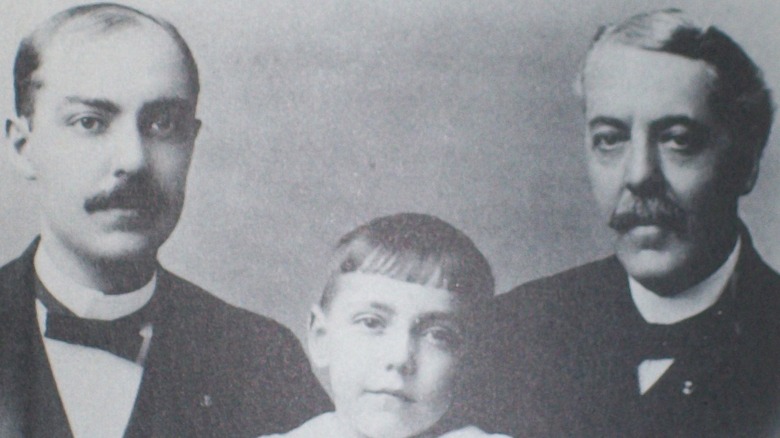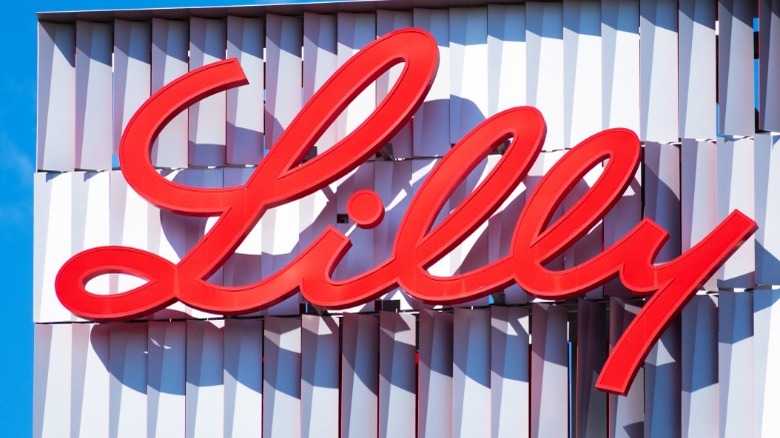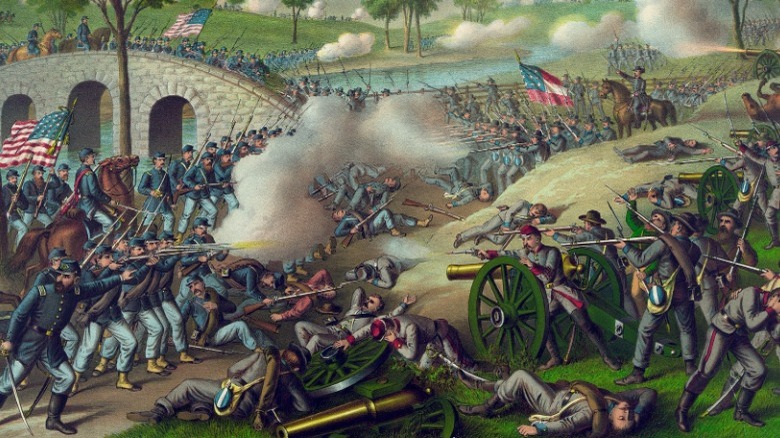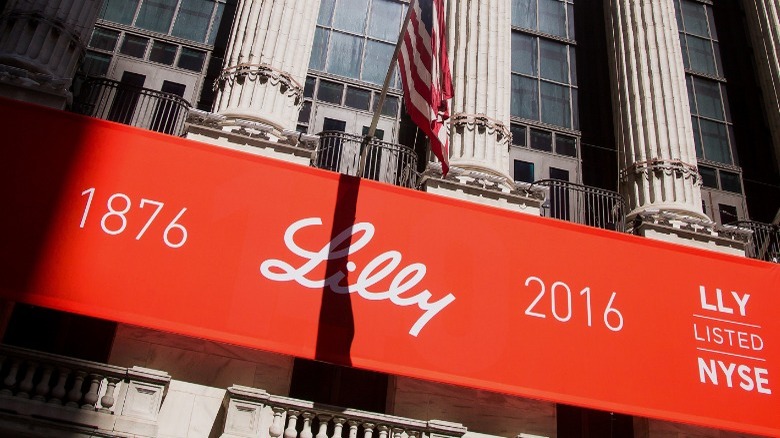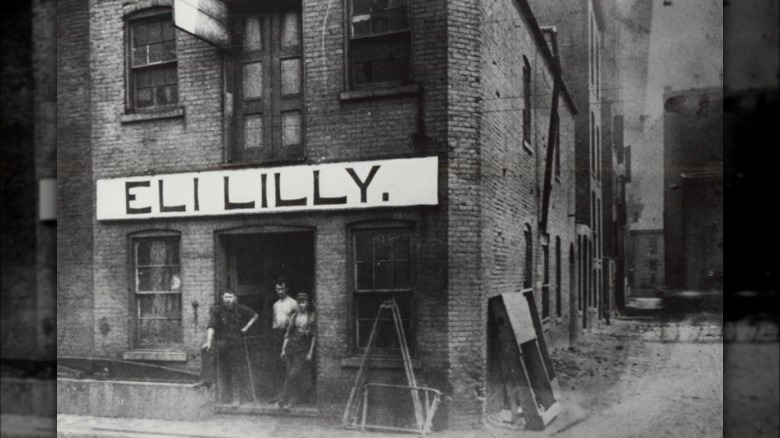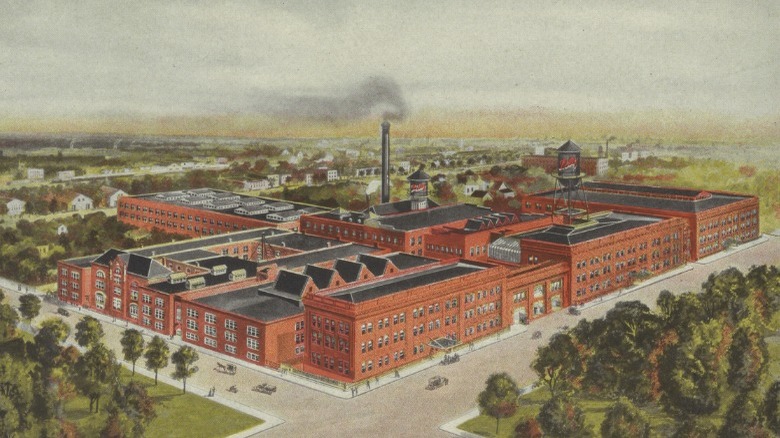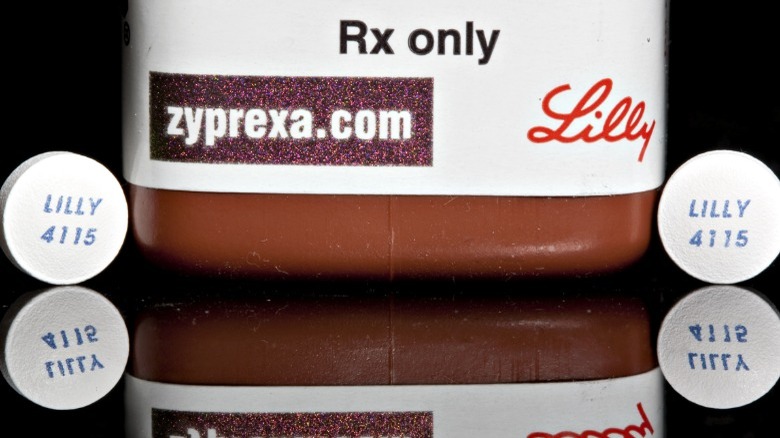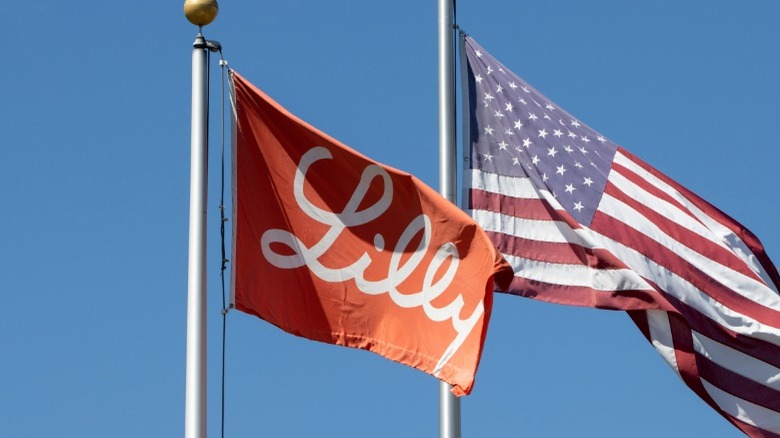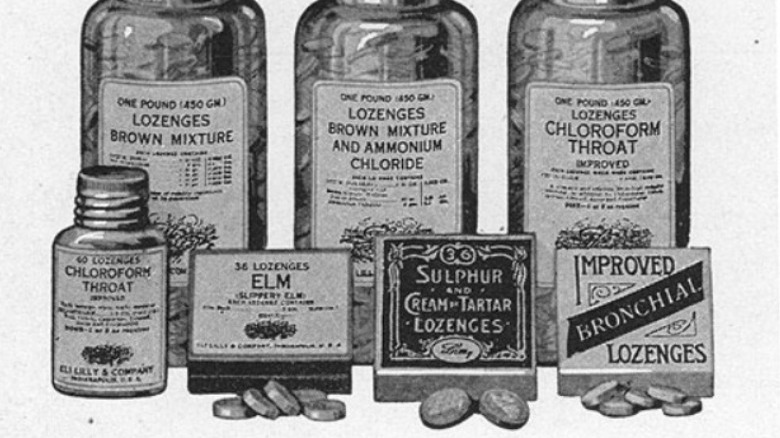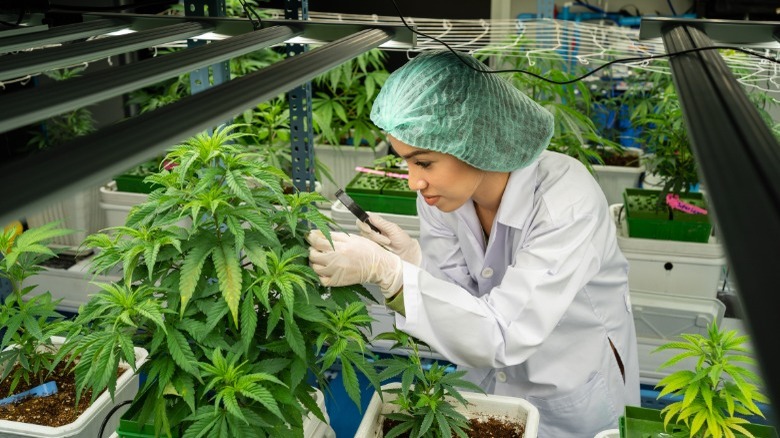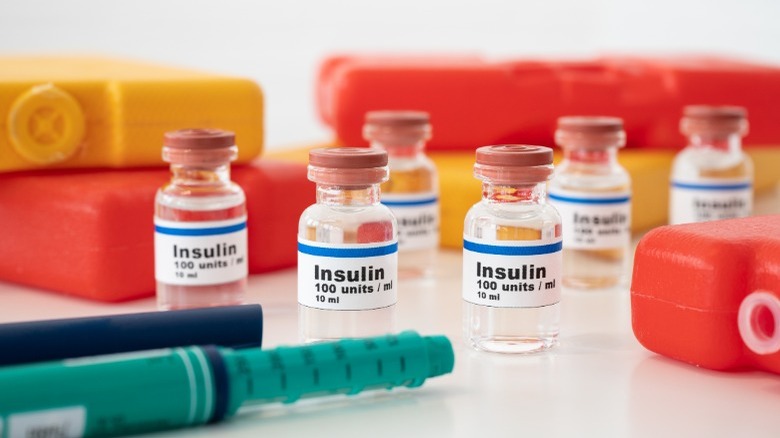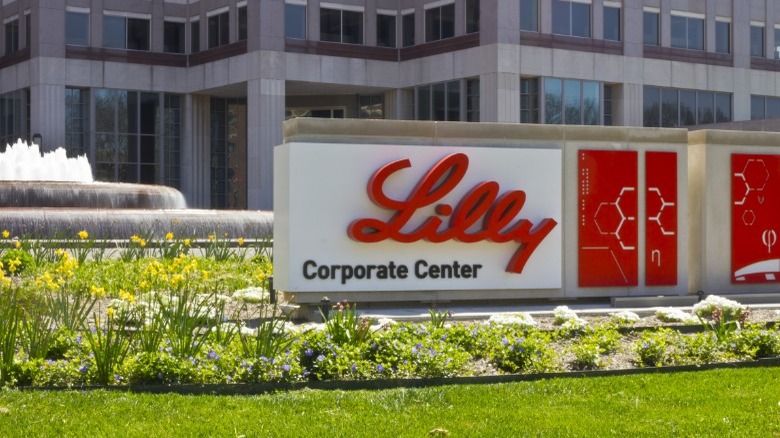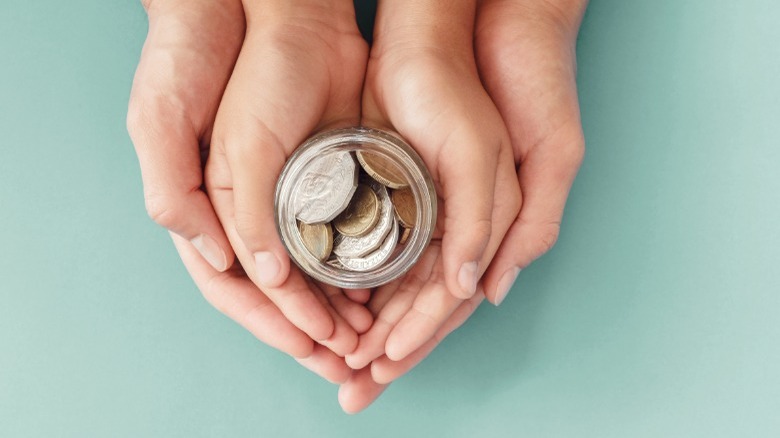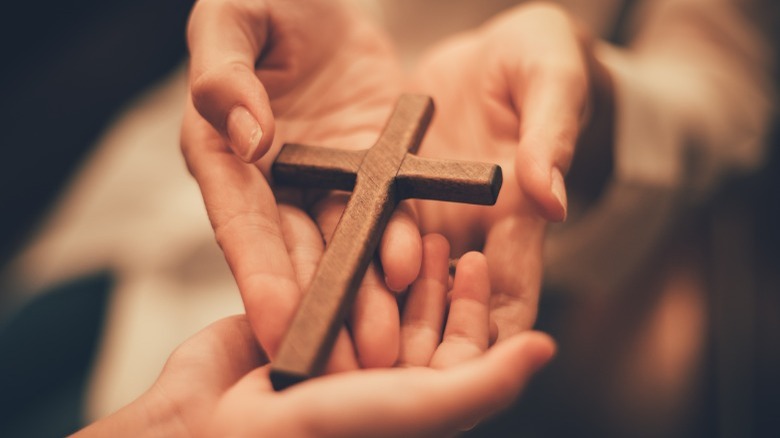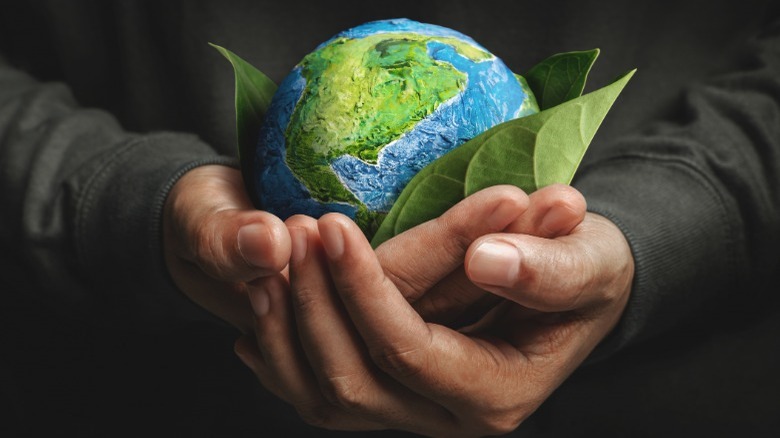Who Was The Real Eli Lilly?
Originally founded in 1876, Eli Lilly and Company has long been one of the most respected medical supply companies in the United States. They are probably most well known for their work with penicillin, the Salk polio vaccine, and insulin in the 1920s-1950s, and they still continue to manufacture many products today (via The New York Times). Yet, as popular as the company is, most people do not know very much about two of its most important leaders, Colonel Eli Lilly or his grandson Eli Lilly Jr.
According to the Lilly Archives (via IN.gov), the elder Lilly was born in the 1830s and was a Civil War veteran before founding the company. His grandson Lilly Jr. was born in the 1880s and took over the company in the 1930s. Under junior, Eli Lilly and Company skyrocketed in sales, adding more than $100 million in annual profits in less than two decades. The company also grew internally to support this growth in sales, going from 1,700 employees to almost 7,000 by 1948.
Behind the company for much of its success were two very complex men who dedicated their lives to improving medicine, as well as philanthropy. Read on to find out about the real Eli Lilly and his grandson, Eli Lilly Jr.
Colonel Lilly was one of 11 children
The story of Eli Lilly and Company begins on July 8, 1838, with the birth of Eli Lilly. He was the eldest of 11 children, and though Lilly was born in Baltimore, Maryland, he spent much of his early years growing up on a farm in Kentucky, per the Lilly Archives (via IN.gov).
When he was just 14 years old, he began attending Indiana Asbury College (DePauw University), and after graduating at 16, he started to become acquainted with the pharmaceutical business by getting a job at the Good Samaritan Drugstore. Lilly was also deeply religious when growing up, and the name of the drugstore intrigued his theological side.
While working at the drugstore, Lilly also joined a local militia in Indiana, and in 1861 he got married. His bride was Emily Lemon, a woman he had grown up with since he was a child. By now, Lilly was settled in Greencastle, Indiana, but soon much bigger and more pressing things would take him away from his beloved town for several years.
Colonel Lilly and the Civil War
When the Civil War broke out in early 1861, Eli Lilly was among the first in the Union to answer the call. According to the Lilly Archives (via IN.gov), he joined up with the Putnam Rifles, 21st Regiment, Indiana Volunteer Militia, where he started the war by performing garrison duty. In November, his son Josiah Lilly was born, and the following summer, Lilly began raising what would eventually become the 18th Indiana Battery of Light Artillery. The 18th Indiana was commanded by Major General William Rosecrans, and Lilly first tasted battle near where he grew up in Kentucky, freshly commissioned as a captain.
In June 1863, Captain Lilly and the 18th Indiana fought Confederate General Braxton Bragg in Tennessee, where they earned the nickname "The Lighting Brigade" for their outstanding tactics and fighting ability. However, the following year, unhappy with his commander General Edward McCook, Lilly joined the 121st Regiment, 9th Indiana Cavalry, as a major.
After a brief stint as a prisoner of war in a Confederate camp in Mississippi, Major Lilly was finally released from captivity in January 1865. That August, he left the army for good: Lilly had eventually attained the rank of colonel, and he decided to stay in the south following his discharge. Today, there is a museum dedicated to Lilly's Civil War service, which is located in Indianapolis (via Museums of the World).
A lifelong connection with pharmaceuticals
Even before Eli Lilly fought in the Civil War, he was already involved in the world of medicine. After graduating from Indiana Asbury College, Lilly soon entered the pharmaceutical business, according to the Lilly Archives (via IN.gov). He began to work as a pharmacist's apprentice at the Good Samaritan drugstore, doing menial tasks for little pay. However, Lilly earned a "certificate of proficiency" while at Good Samaritan, and was eventually allowed to start handling actual drugs.
After bouncing around at a couple of different stores from 1858-1860, Lilly opened his own drugstore in Greencastle, Indiana, in 1861. However, the Civil War intervened for several years, and it was not until 1865 that Lilly could return to private business after four years away. Lilly tried his hand in the cotton industry in Mississippi, but after the death of his wife Emily he returned to Greencastle and re-entered the pharmaceutical industry as a chemist.
In 1869, Lilly remarried to Maria Cynthia Sloan, a woman he had met in church. They had a daughter, Eleanor Wallace Lilly, in 1871, but she passed away at a young age. During this time, Lilly became even more entrenched in the pharmaceutical industry, now working as a partner in ownership rather than as just an employee.
Rejection turned into success
Following his re-entry into the pharmaceutical world after his Civil War service, Eli Lilly entered into several agreements to run pharmaceutical stores. As the Lilly Archives explain (via IN.gov), he first started working with James M. Binford in 1869 to open up a drugstore in the town of Paris, Illinois. Binford and Lilly knew each other after serving together in the war: They now turned to selling patent medicines and animal medicine, as well as soft drinks, with the profits split equally between them.
In 1874, Lilly began to expand into the pharmaceutical manufacturing industry when he opened a firm named Johnston and Lilly with dentist Dr. John F. Johnston. However, the partnership dissolved under bad terms in 1876, and Lilly tried to start working for Augustus Kiefer, another drug supplier in Indianapolis. However, Kiefer instead suggested that Lilly open his own storefront, and Lilly took his advice.
On May 10, 1876, Lilly opened his first store under the banner of "Eli Lilly, Chemist" on Pearl St. in Indianapolis, which is now Eli Lilly and Company. Lilly was just 38 when he began the business, and it proved to be by far his most successful venture.
Making the business a family affair
Eli Lilly's company was a raging success by the time he passed away in 1898. According to "Eli Lilly: A Life, 1885-1977," by the 1890s, the company had grown to employ over one hundred workers and had sales nearing a quarter of a million dollars. Things got so big Lilly had to move to larger facilities, but unfortunately, his end was coming perilously near. Lilly died in 1898, having already left the company in the hands of his son Josiah.
Under Josiah, sales surpassed $1 million, and soon both his kids, Eli Jr. and Josiah Jr., were working for the company (per the Indiana Historical Society). During the First World War, Josiah Sr. worked for the army and supplied them with medical supplies topping $52,000 in value. In the 1920s, the company really became successful after it started developing and selling insulin for diabetes patients, and by the 1930s, they were big enough to start expanding overseas to Europe.
Continuing the family tradition, Lilly Jr. took over Eli Lilly and Company in the 1930s, seeing the company through the Second World War. After the war, Josiah Jr. was put in charge until 1953, but both he and Lilly Jr. stayed active in the company through the late-'60s. Lilly Jr. was the last family member to have control over the company, which ended with his death in 1977.
The childhood of Eli Lilly Jr.
Born on April 1, 1885, 47 years after his grandfather, Eli Lilly Jr. was the son of parents Josiah Lilly and Lilly Ridgley. As described in "Eli Lilly: A Life, 1885-1977," he grew up in Indianapolis on North Tennessee Street, in a house that also held his aunt Margaret Ridgely and his younger brother Josiah Jr.
It was in the nicer part of town in Indianapolis, and Lilly Jr. often spent his time playing with the neighborhood children. In the summer they would ride on their tricycles, and in the winter they had sleigh races. The family often visited Lake Wawasee, and it became one of Lilly Jr.'s lifelong favorite spots. Living a life of extreme privilege, Lilly Jr. spent much of the summer roaming the shoreland and playing with friends.
Though he died when Lilly Jr. was just 13, Eli Lilly Sr. was one of the biggest influences in his life, and his grandson remembered him fondly. He was also close with his father, and once when he was a child he briefly got into trouble while playing near the house of former president Benjamin Harrison.
Eli Lilly Jr.'s family life
In September 1893, when Eli Lilly Jr. was 8 years old, his younger brother Josiah K. Lilly Jr. was born. According to "Eli Lilly: A Life, 1885-1997," though Lilly Jr. loved his brother, he always felt that his parents favored Josiah Jr. over himself, and would recall them being bitter rivals as kids: "[we] hated each other like poison until we were grown." Even as adults, they were still in competition with each other, though Lilly Jr. always had deep love and respect for his brother as an adult.
Lilly Jr. was very close with his father, Josiah Sr., though the same cannot be said about his mother, who elicited barely a mention in his vast memoirs. He may have resented her use of corporal punishment on him, and it also may have stemmed from what he perceived as favoritism towards Josiah Jr.
However, Lilly Jr. still did have a strong maternal influence in his life, in the form of his aunt Margaret Ridgely. The two developed a very close relationship with each other, and upon her death he even dedicated a library in her honor and memory.
Getting into the family business of pharmaceuticals
Like his father and his grandfather before him, Eli Lilly Jr. was involved in pharmaceuticals from a very young age. As related in "Eli Lilly: A Life, 1885-1997," Lilly Jr. himself once said: "[he] was born into the business," and he started to work for his grandfather and father's company when he was just 10 years old. The young Lilly Jr. was a hard worker who won respect from his co-workers for his work ethic.
When he was just 19 years old in 1904, he began to study at the alma mater of his father, the Philadelphia College of Pharmacy (PCP). Lilly Jr. thoroughly enjoyed his time at PCP, attending classes but also having a very active social life, complete with frequent trips to the theater to see light musicals.
Graduating from PCP in 1907, Lilly Jr. was immediately put on the company's board of directors and given the opportunity to have some of the company's stock. Lilly Jr. was also given a check by his grandfather for just north of $2,700 upon graduation.
Eli Lilly and Company ... and cannabis
One of the least known aspects about Eli Lilly Jr. and his company is their connection with cannabis. According to the Indianapolis Monthly, the first traces of his involvement with the plant reach back to his days at the Philadelphia College of Pharmacy (PCP). For his doctorate, he wrote a thesis titled, "The Comparative Physiological Effects of Several Varieties of Cannabis Sativa," which compared Cannabis sativa strains against Cannabis indica strains.
In 1912, Lilly Jr. bought 156 acres of farmland in Greenfield, Indiana, and he started growing cannabis for use in Eli Lilly and Company products. They boasted about their high potency cannabis that they used to sell in tinctures for as cheap as $6 per pint. Supplemented by another property in present-day Conner Prairie, Lilly Jr. had become a full-fledged cannabis farmer, though they now refuse to comment on any of the company's green past.
The company sold at least 23 different versions of cannabis tinctures. The tinctures were used for everything from migraines to sexually transmitted infections. However, in 1937 the U.S. Congress passed the Marijuana Tax Act, which made growing and selling cannabis financially unviable. Soon after, Lilly Jr.'s venture with cannabis ended, and the company has never reintegrated back into the business.
The development of insulin and Eli Lilly Jr.
Though Eli Lilly and Company had seen solid success, following the First World War, they were facing new challenges. For one thing, advancements in medical science were making their outdated medicines seem less effective and thus less popular, according to "Eli Lilly: A Life, 1885-1977". To make matters worse, medical schools were becoming more prominent, and their scientifically based methods began to supplant the patent medicines of old.
In 1919, Josiah Lilly began to invest in research on experimental medications, and in 1920, Lilly Jr. reinvigorated the company's scientific division to help. The new research division started to bear fruit almost immediately. In 1921, one of the company's employees, George Clowes, heard a presentation about a new product called insulin that could be used to fight diabetes. The following year, Clowes and Lilly Jr. were on their way to the University of Toronto to meet with the researchers who had invented it.
In May 1922, they entered into an agreement together for the production and distribution of insulin, under the brand name Iletin. Within a few years, the Lilly Company was distributing hundreds of millions of insulin units worldwide (per Eli Lilly and Company). Today, a century later, they are still involved in the insulin business.
Eli Lilly Jr.'s two marriages
During his life, Eli Lilly Jr. was married two times. His first marriage was to Evelyn Fortune, who he had met as a teenager, according to "Eli Lilly: A Life, 1885-1977." He saw her playing basketball while at school, and over the summers they began to get to know each other while their families vacationed at Lake Wawasee. They attended the same high school, and in August of 1907, they officially married, taking their honeymoon at the lake.
They had one daughter together, Evelyn "Evie," who was born in September 1918. However, by the mid-1920s, they had largely grown apart, part of which had to do with Lilly Jr.'s intensive work schedule. In 1926, they finally divorced, which brought tension between their fathers.
Just a year later, in 1927, Lilly Jr. remarried, this time to Ruth Helen Allison. In Ruth, Lilly Jr. found a real lifelong partner, and they truly loved each other. They remained married until March 1973, when Ruth died from breast cancer. Her death devastated Lilly Jr., who remained lonely without his longtime companion and wife of almost 46 years at his side.
A very philanthropic family
If there is an apt word that can be used to describe both Eli Lilly Sr. and his grandson Eli Lilly Jr., it's philanthropic. As described in "Eli Lilly: A Life, 1885-1977," though Lilly Jr. earned an incredible amount of wealth during his time, he donated the majority of it away. He partially inherited this civic spirit from his grandfather, who was known to be generous and widely remembered for his charitable acts during the depression of 1893. Giving charity was very important for Lilly Jr., and he even worked to instill the spirit in his daughter Evie from a young age.
Yet, Lilly Jr. didn't give money to just anyone, and he truly believed in the causes he funded, which were myriad. He gave both publicly and privately, and in 1937 the Lilly Endowment was created. The endowment was financially backed by the company's stock, and has largely focused on issues like community development, education, and religion (via the Lilly Endowment).
According to The New York Times, Lilly Jr. was instrumental in the creation and running of the endowment, which had distributed over $250 million by the time of his death in 1977. The endowment is still around today, and funds many Indiana and Indianapolis area schools and causes.
Eli Lilly Jr.'s lifelong devotion to the church
For his entire life, Eli Lilly Jr. was a lifelong follower of the Episcopalian Christ Church. Baptized shortly after his birth in 1885, his family was active in the church, and he was in the church choir as a kid, according to "Eli Lilly: A Life, 1885-1977".
Following his marriage to Ruth Allison in 1927, Lilly Jr. became heavily involved in the church, taking a role in the vestry that he would keep for most of his life. Lilly Jr. funded a church library in the 1920s and later became a junior warden for the church. Lilly Jr. had a very personal relationship with the church, something he tried to instill in his children and grandchildren.
Later in life, Lilly Jr. became active in the affairs of the church, campaigning for leaders and donating huge amounts of securities. He was an early supporter of civil rights, too, and donated to causes that helped advance them. Lilly Jr. stayed with the church throughout his entire life, and always continued to support it.
Eli Lilly Jr.'s last charitable act
On January 24, 1977, Eli Lilly Jr. died at the age of 91 years old. His wife Ruth Allison had died four years prior in 1973, and their daughter Evie Lutz had tragically died even earlier, in 1970. Leaving behind an incredible legacy of innovation and philanthropy, Lilly Jr. had presided over the company's massive rise to success. As The New York Times noted in his obituary, on his 84th birthday in 1969, the state of Indiana had proclaimed "Mr. Eli Lilly Day" in honor of his contributions.
Yet, in one last incredible act of charity, Lilly Jr. made a massive donation upon his death. Leaving behind no children, Lilly Jr. donated all of his stock away when he passed. According to "Eli Lilly: A Life, 1885-1977," owing to an agreement with Ruth, when he died $33.8 million worth of stock was donated to 11 institutions that she had wanted.
This amounted to 20% of his personal stock, and he donated the remaining 80% to 13 separate institutions of his choice. These included colleges, schools, museums, and of course, the church. The total value of his estate was more than $165 million upon his death, much of which went to charity.
